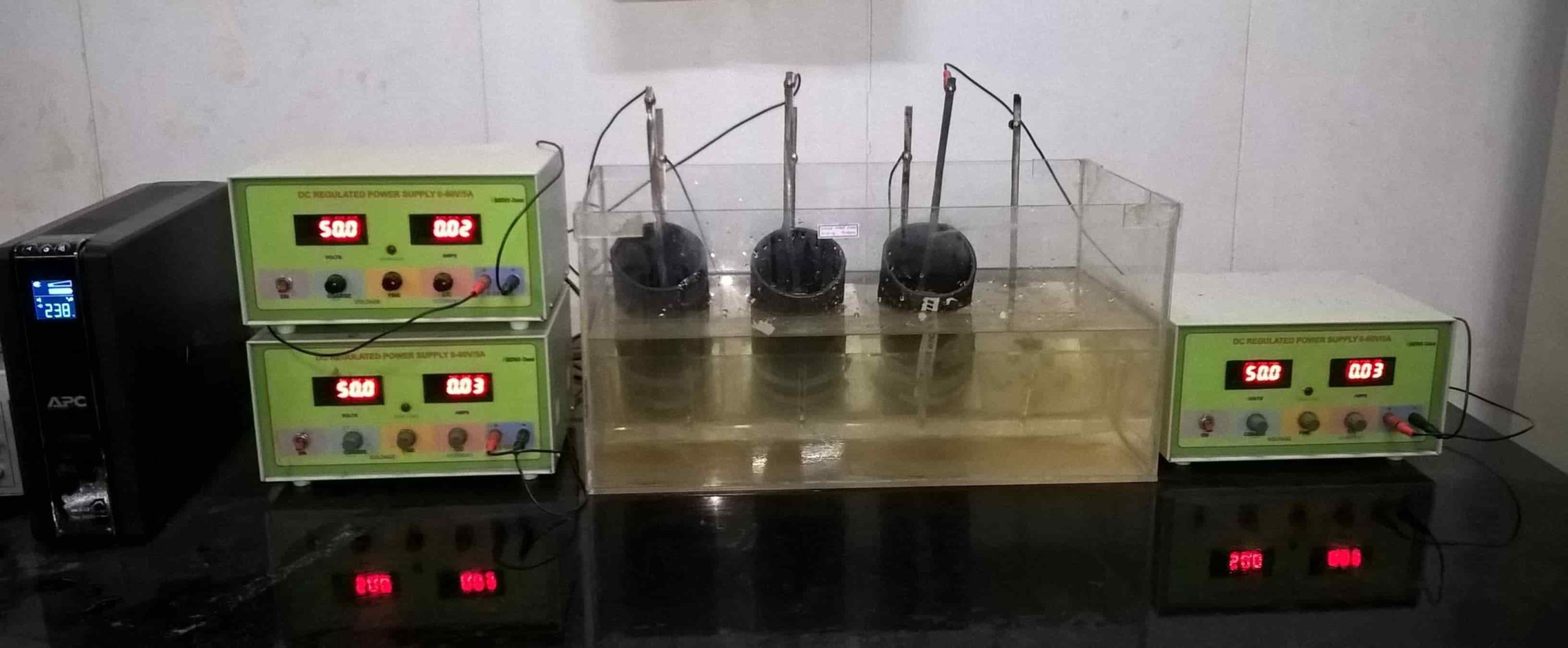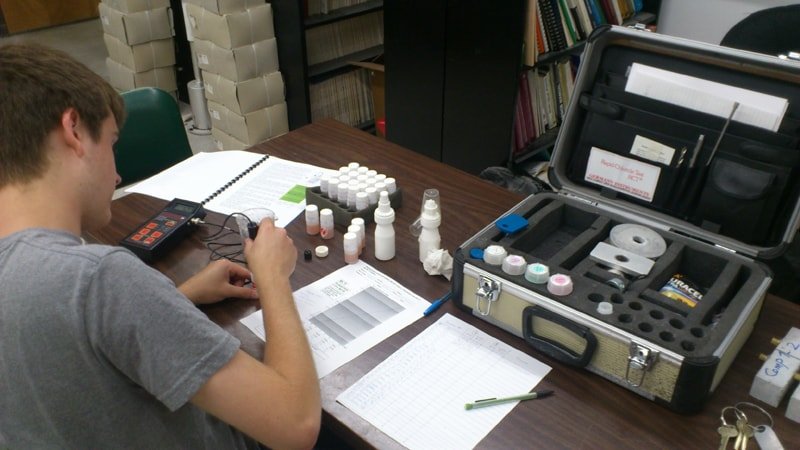
Construction of the concrete structure according to the required specification and standards give excellent durability and performance over their service life. Corrosion of reinforcement steel cannot occur when the reinforcement steel is encased in concrete. The surface of the reinforcement steel is covered by a stable protective oxide film that is formed in the alkaline environment. The alkaline environment is created by the hydration of the cement in concrete. But due to chloride attack on concrete, reinforcement steel gets corroded. Chloride content test for concrete determines the level of chloride ions and ingress of the chloride ion which destroys the protective layer of steel.

Concrete Chloride Content Test Setup
Courtesy - IIT Bhubaneswar
Also, learn other tests which are used to check the Hardened Concrete.
Rebound Hammer Test Procedure
Ultrasonic Testing Procedure
Concrete Pull Out Test
Carbonation Test
Concrete Core Test
Nowadays chemical tests of concrete are very useful to evaluate the future performance of the RCC framed structures. The chloride attack is becoming more and more serious problem for the concrete component of the structures.
Why Chloride Content Test?
What is Chloride Attacks?
Steel as is such protected by the concrete cover. Steel develops a protective layer on its surface which is self-generated after cement hydration. As long as that protective oxide film is present, the steel remains intact. When the chloride attacks on the concrete, it destroys that protective layer and corrosion starts taking place resulting in subsequently reducing of strength the strength, serviceability, and aesthetics of the structure. This ingress of chloride ions in concrete is known as Chloride attack.
What are the Possible Reasons of Chloride Attack?
Chloride can Originate From two Primary Sources:
01. Internal Chloride:
- This is the chloride which increases at the time of concrete mixing. The increase in the level of chloride is due to the mixing of accelerating admixtures which are calcium chloride (CaCl2) based.
- The use of contaminated aggregate and sea water at a time of concrete mixing also increase the level of chloride ions in concrete.
- Furthermore, use of saline contaminated water also increases the level of chloride in concrete.
02. External Chloride:
- External chloride is the chloride which ingresses into the concrete during post hardening. Here the concrete is directly affected by sea water.
- External chloride also enters in the form of an airborne salt spray in the structure next to the coast.
Which Factors Affect the Chloride Attack?
- The corrosion occurs when the concentration of chloride at the reinforcing steel exceeds a threshold concentration where the passive layer protecting the steel breaks down.
- The alternate wetting and drying of concrete also affect the process of chloride attack.
- The chloride attack on concrete is worse in hot climates.
- The permeability of concrete and binding capacity of chloride affect the chloride attack. Type of cement and cement content of concrete also affect the chloride attack.
It is necessary to check the trends of origin of chlorides (i.e. external source or contaminated sand or aggregates). It is also necessary to check their movement through the concrete. Chloride content test of concrete can estimate the level of chloride ions at a depth of reinforcement steel from the broken sample.
What is the Procedure of Chloride Content Test for Concrete Structure?
There are two types of chlorides present in concrete, fixed (Water insoluble) and free (water soluble). Both are of importance from corrosion risks point of view.
Estimate the total soluble chloride (fixed as well as free chloride) contents. Compare it with the limiting values specified for the concrete to assess the risk of corrosion in concrete. The total soluble chlorides are determined in accordance with IS: 14959 (Part 2) 2001.
For water soluble chlorides, obtain the water extracts and carry out standard titration for determining the chloride content. It is expressed by water soluble chloride and also expressed by weight of concrete or cement. The water soluble chloride testing gives the average chloride content in the concrete cover region. Further, a level of chloride across the cover thickness will be a more useful measurement. This can permit to make a preliminary estimate of chloride diffusion rate.
What is the Quick Way of Testing Chloride Content of Concrete?
Rapid Chloride Test Kit-4 For Concrete:

Rapid Chloride Content Test Kit
Courtesy - University of Wisconsin Milwaukee
Rapid chloride test method is also known as RCT method and it is one of the most important and quick methods for testing of acid soluble chloride in concrete. On the field chloride content test for concrete includes the use of the chloride ion sensitive electrode. This also known as Rapid Chloride test Kit-4. The rapid chloride test for concrete structure consists of obtaining powdered sample by drilling, collecting and crushing the concrete sample from every 5mm depths. Mix the 1.5gm sample with a special chloride extraction liquid. Measure the electrical potential of the liquid by the chloride ion selective electrode. The chloride content of the sample can be directly determined with the help of a calibration graph relating electrical potential and chloride content. The estimation of chloride limit by rapid chloride test is expressed on the basis of chloride ion.
It is possible to quickly conduct a large number of in-situ test to determine chloride content of the reinforced concrete structure by RTC method. The accuracy of the RTC method is equivalent to standard laboratory titration and has been accepted as such.
All chlorides in concrete do not contribute to corrosion process of the reinforcement steel. It is estimated that between 50 and 75% of the total chloride content in the concrete will be water soluble and will impact the corrosion process. The maximum permissible chlorides concentration are in the range of 0.05 to 0.1% by weight of concrete, which is about 1.1 to 2.4 Kg/m3 ( 2 to 4 lbs/yd3). The maximum permissible chloride limits are also expressed on the basis of the weight of cement, and these are approximately 0.4 to 0.8% when the cement in concrete is about 300 Kg/m3 (500 lbs/yd3).
Must Read:
Uses of Rebound Hammer Test and its Limitations
Which Factors Affects Ultrasonic Pulse Velocity in Concrete?
Advantages of Ultrasonic Inspection in Concrete Structure






























